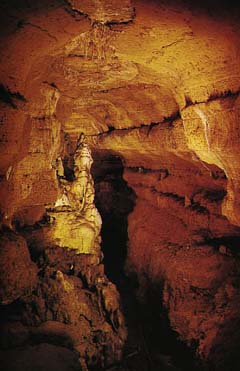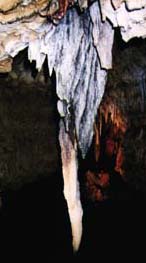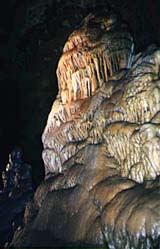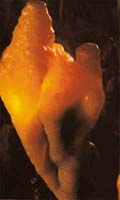
Editorial
|
Fragments
|
Cave of the Mounds
|
Thunderbird
|
Sphinx IV
Register
for our Hall of Records Newsletter!
Questions? Comments? Suggestions? Advertising? Press Releases?
Contact us!

A view of the south cavern. The cavern was originally filled with acidic water, which carved out the soft
limestone to form a the cavern. Look carefully, and you can see the "lifeline" of the cavern snaking along
the center of the ceiling. The lifeline is the crack in the ceiling of the cave through which the acidic
water still drips, continues creating new rock formations.
Image copyright © 1995
Cave of the Mounds.
All Rights Reserved.
|
 he Cave of the Mounds is one of the most spectacular natural wonders the Upper Midwest has to offer. Located in
southern Wisconsin just west of Mount Horeb, the Cave has been the host to millions of visitors since 1940.
It takes its name from the Blue Mounds, two large hills which from a distance appear to have a bluish hue.
The Cave actually underlies the southern slope of the eastern mound.
he Cave of the Mounds is one of the most spectacular natural wonders the Upper Midwest has to offer. Located in
southern Wisconsin just west of Mount Horeb, the Cave has been the host to millions of visitors since 1940.
It takes its name from the Blue Mounds, two large hills which from a distance appear to have a bluish hue.
The Cave actually underlies the southern slope of the eastern mound.
The cave was first discovered by accident in 1939 by workers who were quarrying for limestone at the foot of the
eastern mound. Using dynamite, they blasted out huge chunks of limestone, only to find a great underground tunnel
where their quarry had once been. The underground tunnel turned out to be a limestone cavern more than 20 feet high,
opening into numerous other rooms and galleries.
The discovery attracted so many visitors so quickly that the cave had to be sealed off in order to preserve it.
Unfortunately, during the early days, souvenir hunters actually broke off numerous stalagtites and stalagmites,
the stumps of which can still be seen. Fortunately, most of the cave's natural features were preserved by the
temporary closing, and the cave was reopened to the public in 1940.
The story of the formation of the cave begins over 400 million years ago, during the Ordovician Period of
Earth's geologic history, with the formation of the limestone rock from which the cave was carved. During

One of many stalagtites to be be found in the cave. The bright coloring in the stalagtite is caused by the
presence of brightly colored minerals such as iron and manganese oxide.
|
this period, warm, shallow seas covered much of North America. These seas teemed with shellfish, whose decaying
shells over millions of years accumulated to create massive quantities of limestone rock.
The Cave itself began to form around a million years ago. The shallow inland seas had receded, but the water
table remained high, and the layers of limestone created by the shells of uncounted shellfish remained
saturated with water. The top layer of this water table became acidic due to rainwater and melting snow
combining with carbon dioxide as they seeped through the surface soils, forming carbonic acid. This acid,
though weak, is capable of dissolving limestone, and a large crack in the surface rock allowed a large amount
of carbonic acid to seep through and dissolve out large cavities in the rock. This crack, called a "lifeline",
was responsible both for the initial formation of the cave, and for the spectacular rock formations that would
eventually be formed therein.

Not so much a stalagmite as a vast pile of calcite, or "cave onyx", this stalagmite will eventually grow
to the ceiling to form a mighty column.
|
Over time, the water table subsided, allowing the long, undulating cavity formed by the acidic water
to fill with air. Without the water to dilute it, water droplets falling through the lifeline, filled with
calcium carbonate after filtering through the limestone, fell directly on the rock floor, each drop leaving
a small amount of calcium carbonate behind it. Over time, each of these small amounts of calcium carbonate
formed "speleothems", the most common of which are known as stalagtites, columns that grow from the ceiling
of the cave down, and stalagmites, columns that grow from the floor of the cave up. The amount of
time it takes to build a speleothem varies, but it typically takes anywhere from 50 to 150 years
per cubic inch of material.
Stalagtites start off as small rings of calcium carbonate, which gradually form long, hollow straws. Over time
these straws become plugged, and the stalagtite begins to grow in length and thickness. Stalagmites form in a
similar fashion, except they are never hollow, simply floorbound versions of stalagtites. Eventually,
the stalagtite and stalagmite will join to form a column.
There are many types of speleothems other than stalagtites and stalagmites. One variant type are "ribbon
stalagtites", which are formed when water flows along the ceiling of a cave, instead of falling vertically.
When calcite-laden water drips into shallow pools of standing water, speleothems called "lily pads" or "cave
rafts" can be formed. A light plate of calcite crystals lays suspended on the surface of the water, on top of
which a small stalagmite may form. When the plate becomes too heavy, it sinks, allowing another lily pad
to form. Several pads may form one atop another to form a complete stalagmite. Another speleothem variant
is called a "helictite", stalagtites that grow both downwards and sideways. Oolites, or "cave pearls", are
small, pearl-like concretions, where calcite forms around grains of sand, much like pearls.

|
|
Left: A helictite, an unusual form of stalagtite that grows sideways.
Center: A "lily pad", a type of stalagmite that forms in pools of standing water.
Right: Two oolites, or "cave pearls", that form in much the same way as standard pearls do.
Images copyright © 1995
Cave of the Mounds.
All Rights Reserved.
|
The brilliant colors to be found in various speleothems are due to the mixture of minerals present in the
water. Red and brown colors are caused by iron oxide, and blue and grey colors are caused by the presence
of manganese oxide. Some speleothems are partially luminescent, giving off light for a brief period after

This calcite structure is briefly luminous after having been exposed to bright light.
Roll over it to see!
Image copyright © 1995
Cave of the Mounds.
All Rights Reserved.
|
exposure. The effect of these brilliant colors creates brilliant vistas of color, inspiring some to coin
colorful names for the various areas to be found throughout the cave, including "The Dream River Room"
"The Gem Room", "The Painted Waterfall", and "The Cathedral Room".
Some of these rooms wind on for hundreds of feet leading, some believe, to yet more passages in the deep unexplored
recesses of the cave. Though there have not yet been found any additional passages or connecting caves, some believe that
there are yet more passageways and caves connecting the Cave of the Mounds with a network of other caves to be found
throughout the area.
The Cave of the Mounds is open daily spring, summer, and fall, but during the winter it is open weekends
only, with scheduled guided tours year round. The Cave is located twenty miles west of Madison, Wisconsin,
just off of U.S. Highways 18 and 151 between Mount Horeb and Blue Mounds. For more information, contact:
Cave of the Mounds, Brigham Farm, P.O. Box 148, Blue Mounds, WI 53517; phone: (608)437-3038;
email:
info@caveofthemounds.com. 
Selected images and Cave of the Mounds logo Copyright © 1999
Cave of the Mounds. All Rights Reserved.

 Official Cave of the Mounds site
Official Cave of the Mounds site
Editorial
|
Fragments
|
Cave of the Mounds
|
Thunderbird
|
Sphinx IV
Register
for our Hall of Records Newsletter!
Questions? Comments? Suggestions? Advertising? Press Releases?
Contact us!


 Cultural Map of Wisconsin:
Cultural Map of Wisconsin:
Wisconsin's History, Culture, Land, & People
More Than 1200 Sites of Interest
by David Woodward, Onno Brouwer (Contributor), Steven Hoelscher,
Robert C. Ostergren (Contributor)
This extraordinary map, the first of its kind created for any state, is a wonderful way to discover
the history, culture, land, and people of Wisconsin. Nearly 1500 points of interest are located on
the map, including the sites of Laura Ingalls Wilder's Little House in the Big Woods near Pepin,
the World's Largest Fish Fry at Port Washington, John Muir's boyhood farm near Montello, the
Honor the Earth Pow Wow at Lac Court Oreilles, the nation's first kindergarten in Watertown,
Hoard's Dairy....
Click
here
to buy this book.
 Wisconsin's Past and Present: A Historical Atlas
Wisconsin's Past and Present: A Historical Atlas
by Wisconsin Cartographers' Guild, Wisconsin Cartographers Guild, William Cronon (Introduction)
Despite Wisconsin's rich history, no historical atlas has been produced in the state since 1878.
The Historical Atlas of Wisconsin, created by the Wisconsin Cartographers' Guild, has filled
this void with a fascinating and colorful portrait of the state's complex development. This useful
and entertaining guide, produced to mark 150 years of statehood, provides a lasting resource for
map lovers and history buffs of all ages, and anyone interested in Wisconsin's heritage. The Atlas
features more than 100 pages of historic and geographic data, including full-color maps,
descriptive text, photos, and illustrations.
Click
here
to buy this book.
Wisconsin: Off The Beaten Path
Martin Hintz, Daniel Hintz
Click
here
to buy this book.

 Serpent Mound
Serpent Mound
Rusty Crutcher
Rating:




Crutcher's "Serpent Mound" is an excellent blend of piano and keyboards, Lakota flute, ocarina, and
exotic percussion, plus subtly blended environmental recordings. I highly recommend this CD as one
of the best of its genre I have heard.
Click
here
to buy this CD.
